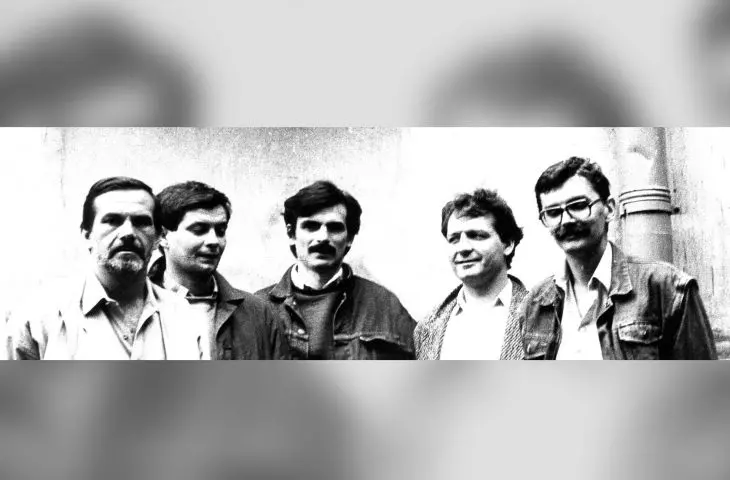Archival materials on the figure of Stanislaw Denieka are published in connection with the premiere of a film about the architect, organized by the Malopolska Chamber of Architects of Poland.
The mention comes from A&B 02/2022.
I met Staszek forty-one years ago, I was studying in my second year. He was an assistant under Professor Cęckiewicz and an architect who had already won a competition and realized the Polish Embassy building in New Delhi. He made a huge impression on me. Faith in ideas, the strength and enthusiasm with which he presented them infected everyone who came into contact with him.
"Żaczek"
In January 1981, Staszek became the head of the Academic Architecture Studio of the Student Labor Cooperative "Żaczek," which was licensed to do projects at a time when architectural practice was carried out exclusively in state design offices. It was a unique place, also because architecture students, among others, worked there. I soon joined a team that, under Staszek's direction, began working on a series of large international architectural competitions. We called this time the "Era of Large Competitions." Among them, the 1982 competition entry for the Grande Arche building in the La Defense district of Paris is particularly noteworthy. Staszek's extraordinary design intuition prompted him with a concept ideologically identical to the work of competition winner Johann Otto von Spreckelsen. The Grande Arche building took the form of a cubic block enclosing an open space, closing the Parisian historical axis. The motif of this design was the basis for the logo of the Academic Architecture Studio - a cubic stool.
A considerable success of the APA team under Staszek's leadership was winning the Grand Prix in December 1985 in the competition of the First Architecture Biennale in Cracow for the project to rehabilitate the Old Gasworks in Kazimierz.But undoubtedly Staszek's greatest success from this period was winning the closed architectural competition for the building of the new terminal of the Balice airport (S. Deńko, D. Gruszka, J. Duliński and P. Wróbel, 1988).This was an outstanding project - one of the milestones in his work. The functions of the terminal were encased in a glass, technologically modern cuboid, which, thanks to the glazed edges of the roof, gave the impression of lightness and connectivity with the sky. The identity of the building was determined by the use of sandstone on the fragments and the symbolically processed details of the wing in the main entrance to the building and on the finial of the tower. In architecture he was always looking for novelty, originality of ideas, attractiveness of form and detail, and harmony with the surroundings. Unfortunately, as a result of multiple reconstructions, the building has not survived to this day in its original form.
Although we worked together almost continuously for forty-one years, we have always recalled this period as one of the greatest in our professional lives - a time of unfettered creativity, filled with Staszek's bold ideas, discussions, emotions and friendship. It was friendship, kindness and respect that characterized his attitude to people.
Oslo Opera House - International Competition
design: 1999
Authors: Pride Architects AS, Vision, Iproplan Planungsgesellschaft mbH, Ed Berentsen, Frithjof Wiese, Marian Mikołajski, Jan Wang-Norderud, Stanisław Deńko, Robert Kuzianik
Project team: Joanna Dubiel, Marcin Jakub Gondek, Wojciech Kasinowicz, Marcin Pawłowski
Photo: Pride Architects AS ©Vision
United States
In 1990 Stanislaw Deńko was hired at the College of Architecture of the University of Tennessee in Knoxville in the United States, where he worked for three years as a teacher. He received an Award of Merit for his achievements in teaching and design work. In a student competition for the adaptation of a military airport complex into a civil aviation center in Nashville, a team of students under the direction of Stanislaw Denieko won first prize ex aequo. His work at the university fulfilled his extraordinary need to share his experience, knowledge and creative enthusiasm with young people.
APA
In 1990, on the wave of political changes and by agreement with the "Żaczek" cooperative, the Academic Architecture Studio was transformed into a limited liability company called APA Agencja Projektowa "Architektura". However, already in the fall of 1991 there was a split. Stanislaw Deńko, Marek Dunikowski and Artur Jasinski left the company and, together with Wojciech Miecznikowski, founded DDJM Biuro Architektoniczne. With time, further divisions followed: Dariusz Gruszka (1992) and Robert Kuzianik (1996) left APA, while DDJM was left by its co-founders Stanisław Deńko in 1994 and Artur Jasiński in 2002. As a result of these transformations, APA gave rise to a number of design studios. These include: APA Czech-Duliński-Wróbel; DDJM by Marek Dunikowski, Biuro Architektoniczne Artur Jasiński i Wspólnicy, Q-Arch by Robert Kuzianik, KKM by Marek Kozień, Agencja Architektoniczna Alex-Us by Ryszard Aleksandrowicz, Ab-Arch by Dariusz Gruszka, Archipraxis by Marek Kamiński,the American firm Path Architecture PC by Wojciech Oktawiec, and just Vision by Stanislaw Deńko, an architectural firm he founded in 1993 with American architect Glenn Lewis after returning from the United States.
Oslo Opera House
Photo: Pride Architects AS ©Vision
UMK
In 1995 he won the competition for the position of Architect of the City of Cracow. It was an extremely important moment for the city: an administrative reform was in progress, which in 1990 restored local self-government and unleashed extraordinary investment energy in the city. In 1994, a new building law was adopted, as well as the first zoning law created in democratic Poland. Local governments were granted planning authority, public participation in the urban planning process was increased, and new planning documents were created. In the same year, a new General Plan of the City of Cracow was also passed. All this involved enormous challenges for the City Architect, who at the time also served as Director of the Department of Architecture and Urban Planning at the Cracow City Hall, which included, among others, the Office of Spatial Planning of Staszek's choice headed by me at the time. Among the more important tasks at that time were: the project of the Krakow Transport Center (led formally and substantively by Stanislaw Deńko as coordinator) and the preparation of assumptions for the Study of Conditions and Directions of Spatial Development of the City of Krakow, which to this day remain relevant in subsequent planning documents of the city. Working for his beloved City was his lifelong mission.
Auditorium Maximum of the Jagiellonian University
design and construction: 2001-2005
Authors: Wizja Stanisław Deńko, Robert Kuzianik
cooperation: Marcin Przyłuski, Przemysław Skalny, Wojciech Korbel design team: Małgorzata Deńko, Anna Marek-Pelc, Marek Kamiński construction: Czesław Hodurek
acoustics: Lesław Stryczniewicz
Photo: Wojciech Krynski © Vision
Vision
After leaving office in 1999, there was a revival of the Wizja office, also with my participation. A number of award-winning projects were created, including a competition design for the Oslo Opera House building (Wizja/Pride), public buildings and residential buildings. However, our greatest success at that time was the winning competition for the Auditorium Maximum of the Jagiellonian University (S. Deńko, R. Kuzianik, 2001). The monumental block with a classical but contemporary columnar facade with an arcade and staircase, referring to the traditional buildings of the University with the brick used for the finishing, contains inside, among other things, a spacious hall and an auditorium for 1,200 people, the shape of which refers directly to classical patterns. During the development of the project, the symmetry of the building's plan was disturbed in such a way as to save the oak tree standing there, which, together with the bench underneath it - designed by Staszek - was named "Professor Franciszek Ziejka's Oak" in memory of the then rector of the Jagiellonian University. The building was put into use in September 2005.
Auditorium Maximum of the Jagiellonian University
photo: Wojciech Krynski © Wizja
Throughout all these years we have returned to work together, repeatedly entering architectural competitions. In 2020 we qualified for the second stage of the competition for the Stanislaw Wyspianski Museum. Still in the summer of 2021, we worked together to develop the architectural competition for the building of the headquarters of the Camerimage festival in Toruń. Once again, it was a wonderful intellectual adventure, full of the joy of mutual understanding and a common goal.
At the time, I did not anticipate that this would be our last competition....
Satnislaw Deńko on the steps of Auditorium Maximum of the Jagiellonian University
© Private Archive






































